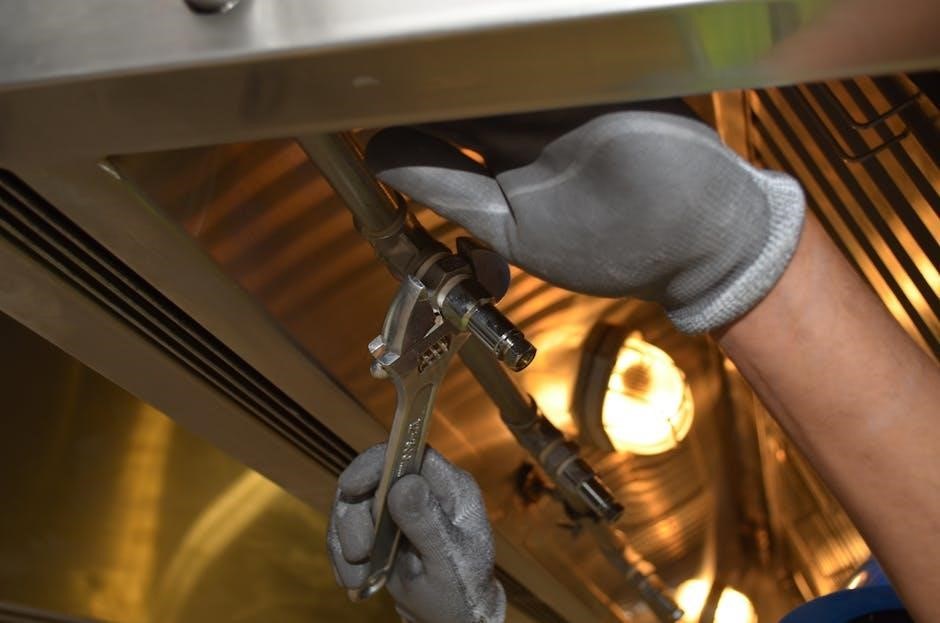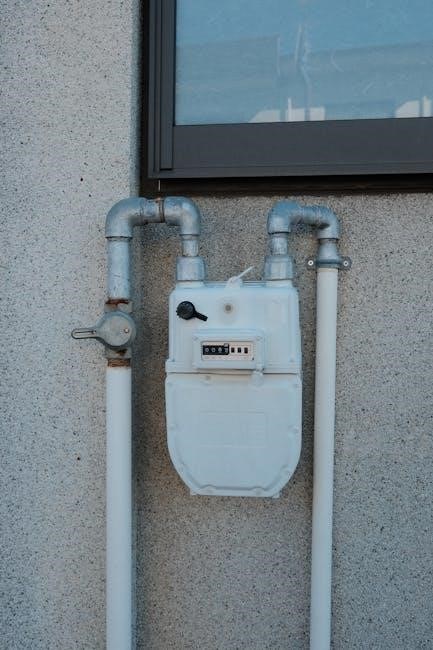D1 and D2 pipework regulations outline specific requirements for discharge pipes in buildings, ensuring safe and efficient water supply systems are installed and maintained properly always․
Understanding the Basics
To understand the basics of D1 and D2 pipework regulations, it is essential to familiarize oneself with the terminology and concepts involved․ The regulations outline the requirements for discharge pipes in buildings, including the materials and sizing of the pipes․ According to the regulations, metal pipes are required for discharge pipe D1 upstream of the tundish, while suitable plastic pipes may be used for downstream pipe D2․ The regulations also provide guidance on the installation and maintenance of the pipes, including the minimum distance before a bend and the requirements for a continuous fall․ By understanding these basics, individuals can ensure that their pipework systems are compliant with the regulations and function safely and efficiently․ The regulations are outlined in Approved Document G, which provides detailed guidance on the requirements for D1 and D2 pipework․
Acceptability of Using D1 and D2 Pipes
The use of D1 and D2 pipes is acceptable, provided they meet the specific requirements outlined in the regulations․ The pipes must be installed and maintained in accordance with the guidelines to ensure safe and efficient operation․ The regulations permit the use of metal pipes for D1 and suitable plastic pipes for D2, such as polypropylene pipes complying with relevant standards․ The acceptability of using D1 and D2 pipes depends on their compliance with the regulations, including the material, sizing, and installation requirements․ By using approved pipes and following the regulations, individuals can ensure that their pipework systems are safe, efficient, and compliant with the relevant standards and regulations․ The regulations provide detailed guidance on the acceptability of using D1 and D2 pipes in various applications․

Minimum Distance Before a Bend in D1 or D2 Pipework
Regulations specify minimum distance requirements before bends in D1 or D2 pipework systems always․
Requirements for Metal Pipes

Regulations for metal pipes in D1 and D2 pipework systems are specific, requiring metal pipes to be used for discharge pipe D1 upstream of the tundish․
The use of metal pipes is mandatory in certain situations, and the regulations outline the specific requirements for these pipes, including sizing and installation․
The regulations also provide guidance on the use of copper discharge pipes, including sizing charts and tables to ensure compliance․
The goal of these regulations is to ensure safe and efficient water supply systems, and the use of metal pipes is an important part of achieving this goal․
Overall, the regulations for metal pipes in D1 and D2 pipework systems are designed to provide clear guidance and ensure compliance with safety and efficiency standards, always following specific rules․
Requirements for Plastic Pipes
Plastic pipes are allowed for use in D2 pipework systems, provided they meet specific requirements, such as complying with BS 5254:1976 and BS EN 1451-1:2000․
The regulations outline the acceptable types of plastic pipes, including polypropylene pipes, and provide guidance on their installation and sizing․
Suitable plastic pipes can be used for downstream pipe D2, and the regulations provide information on the relevant standards and requirements․
The use of plastic pipes in D2 pipework systems must comply with the Building Regulations 2010 and other relevant legislation․
The regulations aim to ensure that plastic pipes are used safely and efficiently, and that they meet the required standards for water supply systems, with specific focus on plastic pipe materials and dimensions always․

Regulations for HepVO Valve and Plastic Pipework
HepVO valve and plastic pipework regulations require compliance with specific standards and legislation always properly․
Connecting Pipework and Stack Regulations
The connecting pipework and stack regulations for HepVO valve and plastic pipework are outlined in the Regulations 2010, which provide specific guidelines for installation and maintenance․
The regulations require that the connecting pipework and stack be designed and installed to ensure safe and efficient operation, and that they comply with relevant standards and legislation․
The regulations also provide guidance on the sizing and material requirements for the connecting pipework and stack, and require that they be installed with a continuous fall to prevent back-siphonage and ensure proper drainage․
Overall, the connecting pipework and stack regulations are an important part of the overall regulatory framework for D1 and D2 pipework, and play a critical role in ensuring the safe and efficient operation of water supply systems․
The regulations are available online for reference and guidance․
Building Regulations 2010
The Building Regulations 2010 provide a framework for ensuring that buildings are designed and constructed to meet certain standards of safety, health, and welfare․
In the context of D1 and D2 pipework, the Building Regulations 2010 require that water supply systems be designed and installed to prevent contamination and ensure safe and efficient operation․
The regulations are enforced by local authorities and apply to all new buildings and certain alterations to existing buildings․
The Building Regulations 2010 are supported by Approved Documents, which provide guidance on how to comply with the regulations․
These documents are available online and provide detailed information on the requirements for D1 and D2 pipework, including sizing, materials, and installation standards, to ensure compliance with the regulations and ensure safe and efficient water supply systems․

Discharge Pipe D2 Requirements
Discharge pipe D2 must have a vertical section and continuous fall to ensure proper function and safety always with specific material requirements․
Vertical Section of Pipe
The vertical section of pipe is a critical component of the discharge pipe D2, requiring a minimum length of 300mm below the tundish before any elbows or bends․ This section of pipe must be installed with a continuous fall to ensure proper function and safety․ The purpose of this vertical section is to prevent back-siphonage and ensure that the discharge pipe operates correctly․ According to the regulations, the vertical section of pipe must be at least 300mm long to allow for proper discharge and to prevent any potential hazards․ The regulations also specify that the pipe should be made of a suitable material, such as copper or polypropylene, to ensure durability and safety․ The vertical section of pipe is an essential part of the discharge pipe D2 and must be installed correctly to ensure compliance with the regulations․
Continuous Fall and Material Requirements
The discharge pipe D2 must have a continuous fall of at least 1 in 200 to ensure proper discharge and prevent back-siphonage․ The material used for the discharge pipe D2 must be suitable for the application, such as copper or polypropylene, and comply with relevant standards․ The regulations specify that the pipe material must be resistant to corrosion and able to withstand the operating conditions․ The continuous fall requirement ensures that the discharge pipe operates correctly and prevents any potential hazards․ The material requirements ensure that the pipe is durable and safe for use․ The regulations provide guidance on the acceptable materials and installation requirements for the discharge pipe D2, including the use of polypropylene pipes complying with BS 5254:1976 and BS EN 1451-1:2000․ This ensures compliance with the regulations and safe operation of the discharge pipe․
Regulations ensure safe and efficient water supply systems are installed and maintained properly always with correct materials․
Importance of Following Regulations
The importance of following D1 and D2 pipework regulations cannot be overstated, as it ensures the safety and efficiency of water supply systems in buildings․ By adhering to these regulations, building owners and managers can prevent accidents and minimize the risk of water damage․ Additionally, following regulations helps to maintain the integrity of the water supply system, preventing contamination and ensuring a safe and healthy environment for occupants․ The regulations also provide a framework for the installation and maintenance of pipework, helping to prevent errors and defects that can lead to costly repairs and replacements․ Overall, following D1 and D2 pipework regulations is crucial for ensuring the safe and efficient operation of water supply systems in buildings, and for protecting the health and well-being of occupants․ This is essential for all buildings, including residential and commercial properties․
References
For further information on D1 and D2 pipework regulations, refer to the relevant documents and websites, such as the Approved Document G and the Building Regulations 2010․ The UK government website provides access to the latest regulations and guidance, including the Sanitation, hot water safety and water efficiency guidelines․ Other useful resources include the Planning Portal and the Office of Public Sector Information websites, which offer detailed information on building regulations and standards․ Additionally, the British Standards Institution website provides access to relevant standards, such as BS 5254:1976 and BS EN 1451-1:2000, which relate to plastic pipes and fittings․ These references provide a comprehensive understanding of the regulations and standards governing D1 and D2 pipework, ensuring compliance and best practice․ Relevant legislation and standards are also available online, providing a valuable resource for building professionals and owners․
